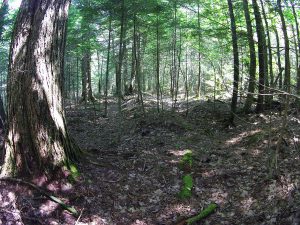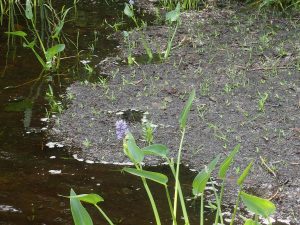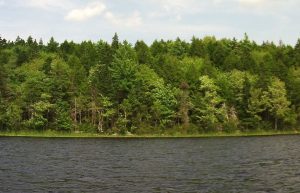 Solar eclipses seem to elicit deep feelings and connections to our larger being, momentarily taking us away from our obsession with the here and now.
Solar eclipses seem to elicit deep feelings and connections to our larger being, momentarily taking us away from our obsession with the here and now.
I had decided to spend the morning of August 21 exploring an area where I thought I might find some old growth forest. In the afternoon, I would paddle down the nearby lake to explore some lakeside wetland under the changing sky of the eclipse.
I wasn’t disappointed with the forest. From the point I landed on the stony beach up to the crest of the hill behind it, I walked in the deep shade of hemlocks, many over 2 feet DBH (diameter at breast height; the largest: 34.1 inches based on circumference), with occasional red maple, sugar maple, yellow birch but only the odd red spruce. There were some large snags, mostly of yellow birch, and of some old, cankerous beech.
The ground had a pronounced pit and mound topography indicating a history of Old Growth on this site and of significant wind events perhaps 150 years ago. Walking amongst them felt like walking through an old graveyard in the shade of equally old trees.There were gaps here and there with young firs and hardwoods on their way upwards, and then I came upon a string of blowdowns, possibly initiated by Hurricane Juan. This was a windy environment historically and remains so today.
Saplings of yellow birch were perched on a couple of these blowdowns. Elsewhere, I saw several instances where yellow birch and hemlock seemingly emerged from a common origin as I had noted on June 21. I mused that sometime I would map the trees and do a statistical analysis to test the hypothesis that these associations between hemlock and yellow birch are non-random. For now (and at my age, probably forever) I will simply look at the relationship between yellow birch and hemlock as an “Acadian forest love affair”.
Finally I reached the crest of the hill. There, and beyond, there was a much more mixed Acadian forest, but still with some very impressive trees. I promised myself to return, and then headed back down to the lake.
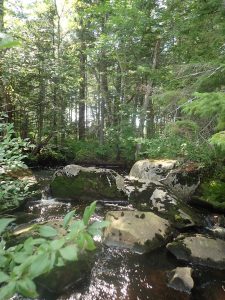
Stream emerging from a forested corridor enters the lake; the light visible through the trees is a recent clearcut.
I paddled through some lakeside wetland to the mouth of a stream where a strong flow of water was enetring the lake after heavy rains a few days before. The water was clear and the temperature perhaps 3-5 degrees below that of the lake at large. It seemed a good story. The forest surrounding the stream purified and cooled the water.
But then I looked at the deposits of blackish debris that bordered the main channel of the stream where it flowed into the lake. It was woody debris, evidently from a large clearcut that abutted the still forested stream corridor. The clearcut, in 2013, included some on-site chipping. Layers of the debris covered large patches by the shore, and extended out over the otherwise sandy bottom, some of it newly colonized by sedges. This was accelerated eutrophication caused by a clearcut that followed the rules, such as they are, for riparian protection.I wondered about the old growth hemlock I had viewed in the morning. Would it still be there in ten years, or would it have fallen to the wooly adelgid? Would we then clean it up out of fear of fire or just to “salvage” it.. or would we allow nature to take its course as it had in the past when those mounds were formed? I envisaged the mixed forest I had seen acting as a seed source to establish the new forest.
Thoughts on a day of a solar eclipse.
I left all thoughts behind as I paddled ‘home’ in the serenity of the early evening.
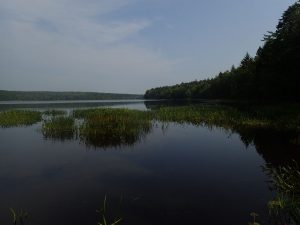 Later I read a bit about Netukulimk.
Later I read a bit about Netukulimk.
I took heart that people who had experienced so much loss of nature and of their own culture still retain a belief that we can live in harmony with the earth, and with each other.

